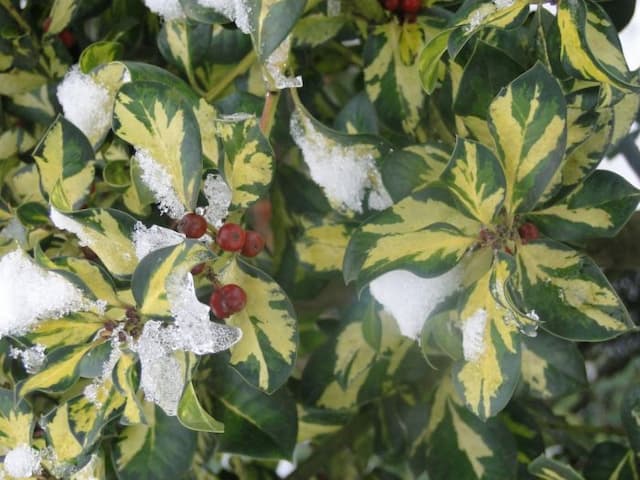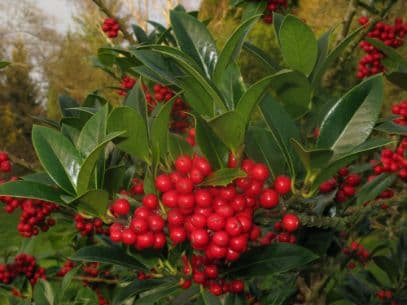Highclere Holly Ilex × altaclerensis 'Hodginsii' (m)

ABOUT
The plant known as 'Hodginsii' is a cultivar characterized by its lustrous, spiny leaves. The leaves exhibit a deep green coloration, and are often edged with a lighter shade, sometimes appearing almost yellowish. The leaves are glossy, adding a reflective quality that can catch the light and create an appealing visual effect in gardens. In terms of its overall shape, the plant displays a bushy, dense habit, with foliage that tends to be quite thick, giving it a substantial presence even without considering its size. As a type of holly, 'Hodginsii' bears the signature berries associated with the genus. The berries are typically bright red, providing a striking contrast against the green foliage and are a source of interest to both humans and wildlife, especially birds. The plant's berries also contribute to its popularity for use in festive decorations during the winter months. The flowers of 'Hodginsii' are less conspicuous than its berries and foliage, but they do provide added texture and interest upon closer inspection. Generally, the blossoms are small and white, and they appear in clusters that can add a subtle charm to the plant in the flowering season. Overall, 'Hodginsii' possesses a classic appearance that is well-suited to formal garden settings or as part of a hedge or border. It is valued for its year-round visual interest, thanks to its evergreen foliage, colorful berries, and seasonal flowers. The combination of these features makes 'Hodginsii' a versatile and aesthetically pleasing option for a variety of landscaping needs.
About this plant
 Names
NamesSynonyms
Highclere Holly
Common names
Ilex × altaclerensis 'Hodginsii'
 Toxicity
ToxicityTo humans
Highclere holly is considered mildly toxic if ingested. The berries contain saponins, which can cause symptoms such as nausea, vomiting, diarrhea, and abdominal pain if eaten in large quantities. However, serious poisoning is rare as the berries are relatively unpalatable, and it would require a significant amount to cause severe toxicity.
To pets
Highclere holly can also be toxic to pets, particularly dogs and cats, if ingested. The plant's berries contain saponins which can cause gastrointestinal upset, including symptoms like nausea, vomiting, and diarrhea. As with humans, serious poisoning is uncommon because pets are typically deterred by the bitter taste of the berries and thus do not consume large amounts.
 Characteristics
CharacteristicsLife cycle
Perennials
Foliage type
Evergreen
Color of leaves
Green
Height
8-10 feet (2.4-3 meters)
Spread
8-10 feet (2.4-3 meters)
Plant type
Shrub
Hardiness zones
6-9
Native area
Cultivar
Benefits
 General Benefits
General Benefits- Ornamental Appeal: Highcross Holly, as it is commonly known, is valued for its glossy, variegated leaves that add color and visual interest to gardens throughout the year.
- Low Maintenance: This cultivar requires minimal attention once established, making it a convenient choice for gardeners of all skill levels.
- Drought Tolerance: Highcross Holly can withstand periods of dryness once fully grown, reducing the need for frequent watering.
- Cold Resistance: It is hardy in many climates, surviving cold winters and thriving in temperate regions, which makes it versatile for various landscapes.
- Wildlife Support: The plant provides shelter and sometimes berries (on female plants) for birds and other wildlife, which is good for biodiversity.
- Privacy Screen: Highcross Holly can be utilized in hedges or as a stand-alone specimen to create privacy in gardens and landscapes due to its dense foliage.
- Soil Adaptability: It can grow in a range of soil types, although it prefers well-drained, moderately fertile ground.
- Seasonal Interest: This holly variety offers year-round interest but is particularly attractive during the winter months when the landscape can be more barren.
 Medical Properties
Medical PropertiesThis plant is not used for medical purposes.
 Air-purifying Qualities
Air-purifying QualitiesThis plant is not specifically known for air purifying qualities.
 Other Uses
Other Uses- Hodginsii Holly can be trained into a topiary form for decorative purposes in gardens or landscapes
- Its dense foliage and prickly leaves can be used to create a natural, impenetrable barrier or hedge for privacy and security
- The branches of Hodginsii Holly can be used in wreaths and holiday decorations, especially due to their association with Christmas
- The wood of the Hodginsii Holly is hard and can be used for crafting small objects such as chess pieces or handles for tools
- As a source of dense, green foliage, this plant is often utilized in theater and film productions for constructing realistic outdoor scenes or backdrops
- Due to its evergreen nature, Hodginsii Holly is a good candidate for bonsai, allowing year-round enjoyment of its miniature beauty
- Hodginsii Holly berries, while not safe for human consumption, can be used as a food source for bird feeders during the winter months
- This plant can be effectively used in landscape designs to enhance the aesthetic of Gothic or Victorian-themed gardens
- Gardeners may use the discarded prunings of Hodginsii Holly as natural mulch to help retain moisture in the soil and suppress weeds
- The thick foliage of Hodginsii Holly may serve as a protective refuge for small birds and beneficial insects, offering shelter and nesting opportunities
Interesting Facts
 Feng Shui
Feng ShuiThe Highclere holly is not used in Feng Shui practice.
 Zodiac Sign Compitability
Zodiac Sign CompitabilityThe Highclere holly is not used in astrology practice.
 Plant Symbolism
Plant Symbolism- Protection: Ilex, or holly, has been associated with protection due to its spiky leaves which can deter animals and negative energies.
- Everlasting Life: Being an evergreen plant that stays green year-round, it symbolizes immortality and eternal life.
- Good Fortune: Holly is often considered lucky and believed to bring good fortune and prosperity, especially when used as a Christmas decoration.
 Water
WaterThe Highclere Holly should be consistently moist but not waterlogged. It is important to water the plant deeply rather than superficially, ensuring the water reaches the root level. Watering should be done when the top inch of soil feels dry, which could be about once a week for outdoor plants, but indoor plants may need to be checked more frequently, as indoor conditions can vary. The amount of water required can range from one to two gallons per week, depending on weather conditions and soil drainage. Over-watering can lead to root rot, so it's crucial to provide good drainage and not let the plant sit in excess water.
 Light
LightHighclere Holly thrives in a variety of light conditions but prefers partial to full sun. Ideally, the plant should receive at least four hours of direct sunlight daily, but it is tolerant of light shade. A spot that offers morning sunlight with some afternoon shade can be ideal to protect the plant from the harsh late-day sun in hotter climates.
 Temperature
TemperatureHighclere Holly is hardy and can tolerate a range of temperatures but prefers a moderate climate. It can typically withstand temperatures as low as 10°F and as high as 90°F, but its ideal temperature lies between 50°F and 75°F. This plant is suitable for growing in USDA hardiness zones 5 through 9, ensuring that it can endure the winter cold while not being exposed to extreme heat.
 Pruning
PruningHighclere Holly should be pruned to maintain its shape and promote healthy growth. Pruning is best done in late winter or early spring before new growth starts. It can be pruned again in mid-summer if needed for shape. Cut back any dead or damaged branches, and thin out the plant to increase air circulation, which helps prevent disease. Avoid heavy pruning late in the season, as this can stimulate new growth that may not harden off before winter.
 Cleaning
CleaningAs needed
 Soil
SoilHighcliffe Holly prefers well-draining, loamy soil with a slightly acidic to neutral pH range of 5.0 to 7.0. The best soil mix can be prepared by combining equal parts of garden soil, compost, and perlite to ensure good drainage and fertility.
 Repotting
RepottingHighcliffe Holly, being a slow-growing plant, does not require frequent repotting. It is generally recommended to repot this variety every 2 to 3 years to refresh the soil and allow for growth.
 Humidity & Misting
Humidity & MistingHighcliffe Holly tolerates a wide range of humidity levels but thrives best in moderate humidity consistent with outdoor environments, approximately 40-60%.
 Suitable locations
Suitable locationsIndoor
Place in bright indirect light, moderate humidity, and cool temperatures.
Outdoor
Plant in partial to full sun, shelter from strong winds, mulch roots.
Hardiness zone
6-9 USDA
 Life cycle
Life cycleIlex × altaclerensis 'Hodginsii', commonly known as Highclere holly, begins its life as a seed, which under the right conditions, will germinate and sprout into a seedling. The seedling stage is characterized by the development of the root system and the first sets of true leaves, which enable the plant to photosynthesize and grow. As the Highclere holly matures, it enters the juvenile phase, where it grows rapidly and starts to form its characteristic dense, evergreen foliage, but has not yet reached reproductive maturity. Upon maturity, the plant begins to flower, producing small white blooms that are followed by red berries, which are often only produced in significant numbers if a compatible pollinator is present, as 'Hodginsii' is a male cultivar. The mature Highclere holly can then establish itself as a fixture in the landscape for many years, growing slowly and continuing to flower and, if pollinated, possibly produce berries annually. Keep in mind that 'Hodginsii', being male, does not bear fruit itself; it primarily serves as a pollinator for female hollies. Over time, the plant may become woody and tree-like, and with proper care, can live for several decades.
 Propogation
PropogationPropogation time
Spring-Early Summer
Ilex × altaclerensis 'Hodginsii' (m), commonly known as Highclere Holly, is typically propagated by semi-hardwood cuttings. The best time to take these cuttings is from late summer to early fall when the current season's growth has started to mature and harden slightly. To propagate, a gardener should select healthy stems that are not flowering and cut a length of 4 to 6 inches (10 to 15 centimeters), ensuring there are at least two to three sets of leaves. The bottom set of leaves is removed to expose the nodes where roots will form. The cut end can be dipped into rooting hormone for better results before the cutting is planted in a mix of peat and perlite or sand. The cutting should be kept in bright, indirect light and high humidity, with consistently moist but not soggy soil, until roots have developed, which can take several weeks. Once rooted, the cutting can be transferred to a pot with standard potting mix and grown on until ready to be planted out.









